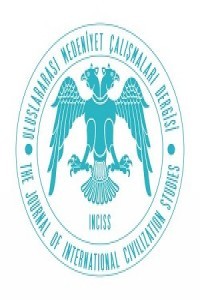Serflik Sisteminin Gelişimi ve Kulakların Ortaya Çıkma Süreci
Serflik, Rusya, Moskova, Kazakistan, Kulak
The Development of the Serfdom System and the Emergence of the Kulaks
Serfdom, Russia, Moscow, Kazakhstan, Kulak,
___
- Acar, K. (2004). Başlangıçtan 1917 Bolşevik Devrimi’ne Kadar Rusya Tarihi. Nobel Yayınları. Ankara.
- Armaoğlu, F. (1997). 19. Yüzyıl Siyasi Tarihi (1789-1914). Türk Tarih Kurumu Yayınları, Ankara.
- Ascher, A. (2002). Russia: A Short History. Oneworld Puclications, Oxford.
- Bucher, G. (2008). Daily life in Imperial Russia. Greenwood Press, London.
- Conquest, R. (1986). The Harvest of Sorrow: Soviet Collectivization and the Terror- Famine. Oxford University Press, New York.
- Figes, O. (1996). A People’s Tragedy: Russian Revolution 1891-1924. Pimlico, Londra.
- Haxthausen, A. F. (1856). The Russian Empire: Its People, Institutions and Resources. Faire, R. (Çev.), Vol. I, Frank Cass & Co. Ltd., Oxfordshire.
- Hubbard, Leonard E. (1939). The Economics Of Soviet Agriculture. Macmillan & Co. Limited, Londra.
- Kort, M. (2008). A Brief History of Russia. Infobase Publishing, New York.
- Kravchinsky, S. S. (1888). The Russian Peasantry: Their Agrarian Condition, Social Life And Religion. Swan Sonnenschein & Co., 2nd Ed., Londra.
- Kurat, Akdes N. (1987). Rusya Tarihi: Başlangıçtan 1917’ye Kadar. Türk Tarih Kurumu Yayınları, 2. Baskı, Ankara.
- Lincoln, W. B. (1982). In the Vanguard Reform: Russia’s Enlightened Bureaucrats 1825-1861. Northern Illinois University Press, lllinois.
- Polunov, A. (2005). Russia in the Nineteenth Century: Autocracy, Reform, and Social Change 1814-1914. Owen, T. C. ve Zakharova, L. (Ed.), M.E. Sharpe, New York.
- Riasanovsky, N. V. ve Steinberg, M. D. (2011). Rusya Tarihi. Dereli, F. (Çev.), İnkılap Kitabevi, İstanbul.
- Stanziani, A. (2014). Bondage: Labor and Rights in Eurasia from the Sixteenth to the Early Twentieth Centuries. Berghahn Books, New York.
- Vernadsky, G. (1936). Political and Diplomatic History of Russsia. Little, Brown and Company, Boston.
- Ziegler, Charles, E. (2009). The History of Russia. Greenwood Press, 2. Baskı, California.
- Walicki, A. (2009). Rus Düşünce Tarihi: Aydınlanma’dan Marksizm’e. Şenel, A. (Çev.) İletişim Yayınları, İstanbul.
- Baş, Ahmet İ. (2017). Serflik ve Bolşevik Devrimi Arasında Çarıkov’un İstanbul Yılları. Üst, S. (Ed.), Turkish Studies, Vol. 12, Issue 26, Ankara, pp 21-40.
- Bohac, R. (1991). Everyday Forms of Resistance: Serf Opposition to Gentry Exactions, 1800-1861. Peasant Economy, Culture, and Politics of European Russia (1800-1921), Kingston-Mann, E. and Mixter T. (Ed.), Princeton University Press. pp. 236-260.
- Christian, D. (1991). The Black and The Gold Seals: Popular Protests Against The Liquor Trade on the Eve of Emancipation. Peasant Economy, Culture, and Politics of European Russia (1800-1921), Kingston-Mann, E. and Mixter T. (Ed.), Princeton University Press. pp. 261-293.
- Curtiss, John S. (1968). The Peasant and The Army. The Peasant in Nineteenth-Century Russia, Vucinich, Wayne S. (Ed.), Stanford University Press, California, pp. 108-132.
- Crisp, O. (1959). The State Peasants Under Nicholas I. The Slavonic and East European Review, Vol. 37, No. 89, Modern Humanities Research Association and University College London, School of Slavonic and East European Studies, Londra, pp. 387-412.
- Domar, E. D. ve Machina, M. J. (1984). On the Profitability of Russian Serfdom. The Journal of Economic History, Vol. 44, No. 4, Cambridge University Press, pp. 919-955.
- Emmons, T. (1968). The Peasant and the Emancipation. The Peasant in Nineteenth-Century Russia, Vucinich, Wayne S. (Ed.), Stanford University Press, California, pp. 41-71.
- Field, D. (2009). The “Great Reforms” of the 1860s. A Companion to Russian History, Gleason, A. (Ed.), Blackwell Publishing, Hong Kong, pp. 196-209.
- Fuller, William C. (2006). The Imperial Army. The Cambridge History of Russia, Vol. II, Lieven, D. (Ed.), Cambridge University Press, New York, pp. 530-553.
- Hellie, R. (2009). Slavery and Serfdom in Russia. A Companion to Russian History, Gleason, A. (Ed.), Blackwell Publishing, Hong Kong, pp. 105-120.
- Hellie, R. (2005). The Structure of Russian Imperial History. History and Theory, Vol. 44, No. 4, Theme Issue 44: Theorizing Empire, Wiley for Wesleyan University, Connecticut, pp. 88-112.
- Hughes, L. (2009). Petrine Russia. A Companion to Russian History, Gleason, A. (Ed.), Blackwell Publishing, Hong Kong, pp. 165-179.
- Ladejinsky, W. (1934). Collectivization of Agriculture in the Soviet Union I. Political Science Quarterly, Vol. 49, No. 1, pp. 1-43.
- Lieven, D. (2006). Russia as Empire and Periphery. The Cambridge History of Russia, Vol. II, Lieven, D. (Ed.), Cambridge University Press, New York, pp. 9-26.
- Mace, James E. (1983). The Komitety Nezamozhnykh Selyan and the Structure of Soviet Rule in the Ukrainian Countryside, 1920-1933. Soviet Studies, Vol. 35, No. 4, pp. 487-503.
- Moon, D. (1992). Russian Peasant Volunteers at the Beginning of the Crimean War. Slavic Review, Vol. 51, No. 4, Cambridge University Press, pp. 691-704.
- Moon, D. (2006). Peasants and Agriculture. The Cambridge History of Russia, Vol. II, Lieven, D. (Ed.), Cambridge University Press, New York, pp. 369-393.
- Pushkarev, Sergei G. (1968). The Russian Peasants’ Reaction to the Emancipation of 1861. The Russian Review, Vol. 27, No. 2, Wiley on behalf of The Editors and Board of Trustees of the Russian Review, pp. 199-214.
- Timoshenko, V. P. (1943). The Agrarian Policies of Russia and the Wars. Agricultural History, Vol. 17, No. 4, Agricultural History Society, pp. 192-210.
- Volin, L. (1943). The Russian Peasant and Serfdom. Agricultural History, Vol. 17, No. 1, pp. 41-61.
- Zakharova, L. (2006). The Reign of Alexander II: a watershed?. The Cambridge History of Russia, Vol. II, Lieven, D. (Ed.), Cambridge University Press, New York, pp. 593-616.
- ISSN: 2548-0146
- Başlangıç: 2016
- Yayıncı: Hakan YALAP
Eski ve Modern İpek Yolunun Jeopolitik Boyutu
Үй-бүлөлүк медицина борборлорунда бейтаптардын канааттануусу: Бишкек шаарынын мисалында
Turdukan KIŞTOOBAYEVA, Kasım BAYNAL
Kimliğim Epistemik Dönüşümü: Gecikmiş Modernitede Bilişsel Sosyolojik Kimliğin Sosyoekonomik İnşası
Duygular Sosyolojisi Bağlamında Kieslowski Sineması: Üç Renk Üçlemesi
“Gurbetin Aradığı Memleket”: Âşık Mürsel Sinan’ın Şiirlerinde Yemek Unsurları Üzerine Bir İnceleme
Osmanlı’da Kültür ve Eğitim Alanında Modernleşme Hareketlerinin Temel Felsefesi ve Diyalektiği
Klasik Türk Şiiri’nde Tenasüh ve Reenkarnasyon
Üniversite Öğrencilerinin Topluluk Önünde Konuşma Kaygı Düzeyinin Belirlenmesi
Erkan EFILTI, Aynazım MAYRAMBEK KIZI
Serflik Sisteminin Gelişimi ve Kulakların Ortaya Çıkma Süreci
